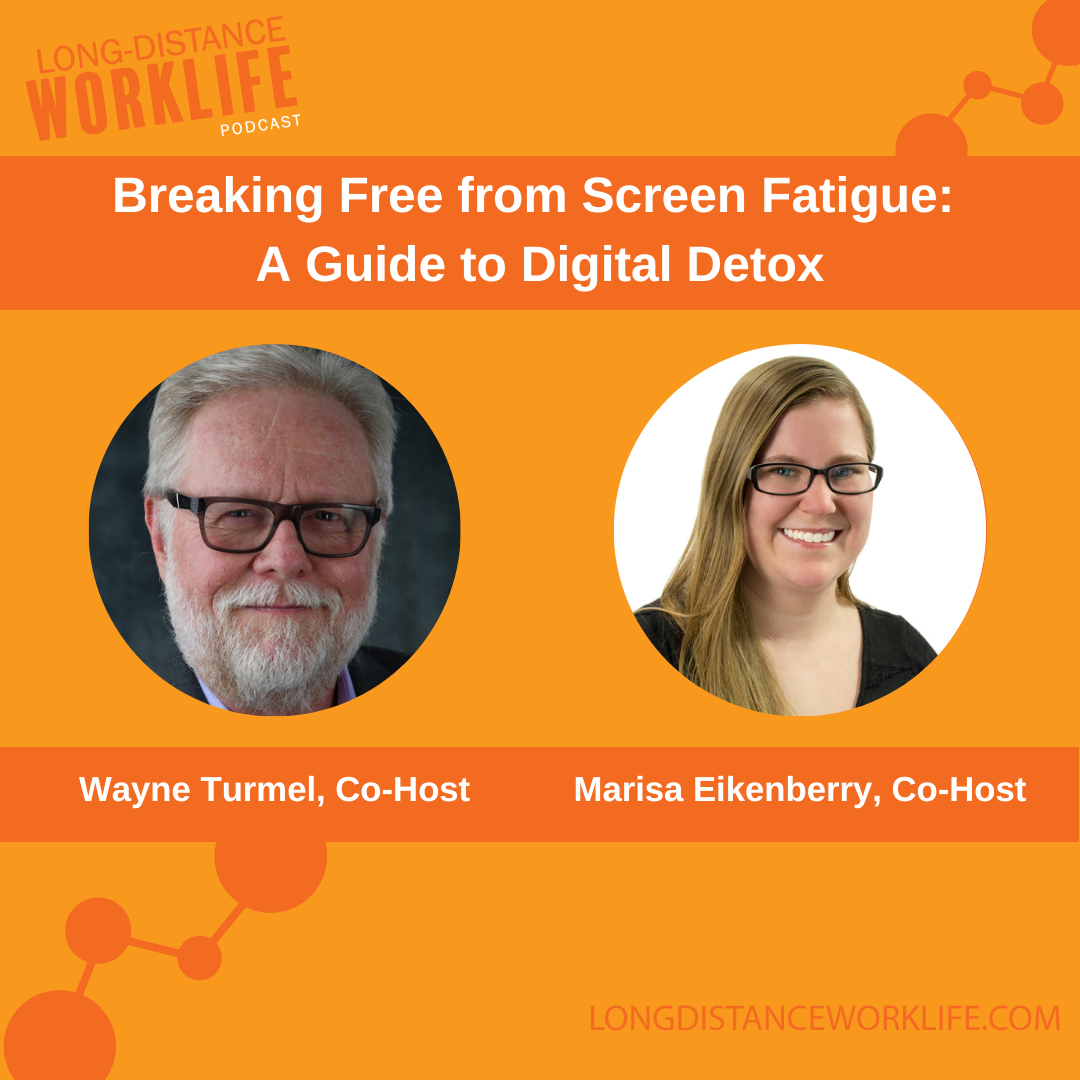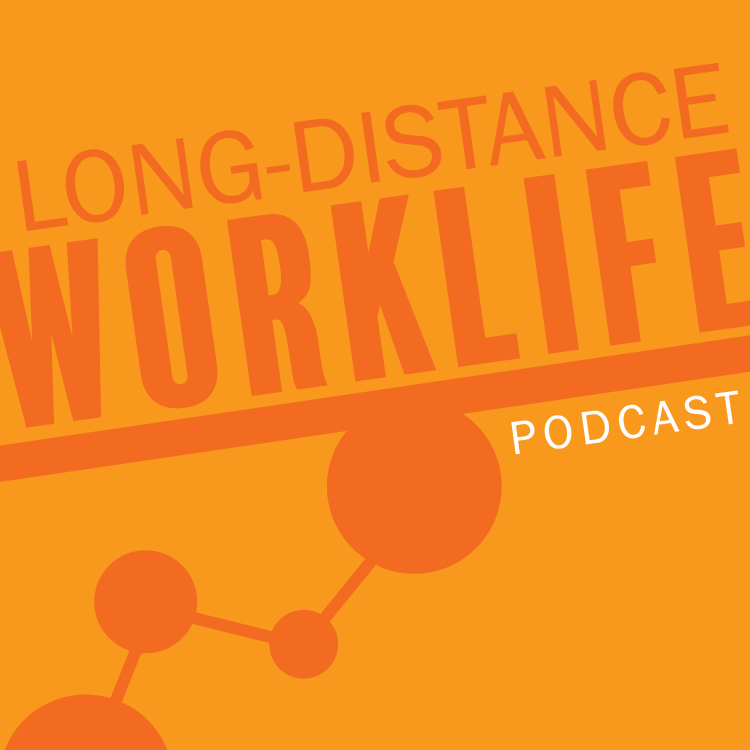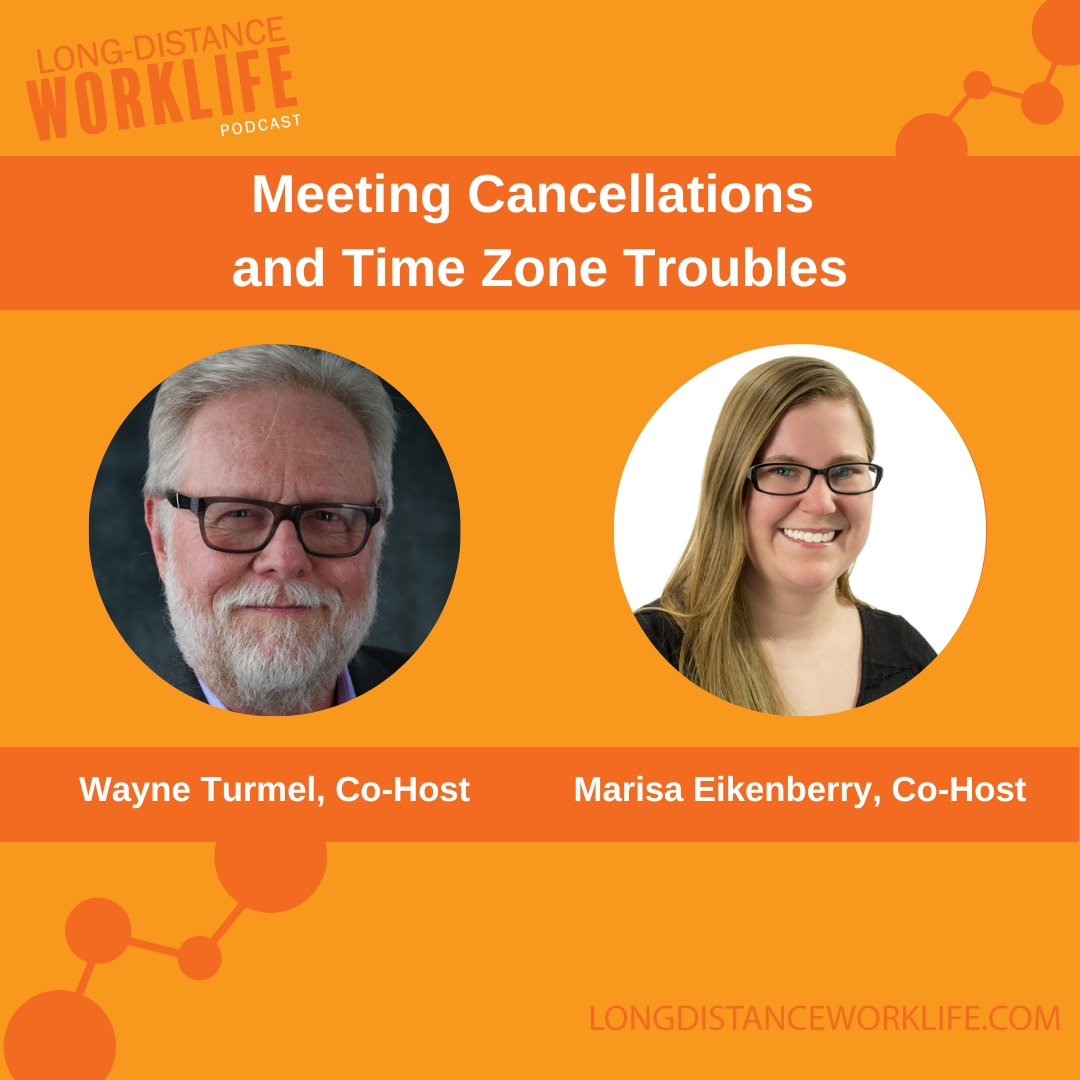Wayne Turmel talks with Ian Parkes from Stockpress.co about document management, workflow control, and generally collaborating over distance. Stockpress is a file management platform for teams who want to spend less time looking for their files and more time using them. Stockpress allows teams to organize, manage, collaborate and share - any file type, from anywhere in the world.
Question of the Week:
What is the problem with the way people share information on remote and hybrid teams?
Additional Resources:
Free Video Series!
Join us for a powerful, 4-part video series titled, Demystifying Remote Leadership. You will learn how to create solid working relationships in a virtual team with more confidence and less stress!
Transcript
Wayne Turmel: Hi everybody. Welcome to another episode of The Long-Distance Worklife Podcast. My name is Wayne Turmel. I'm your humble host today. We are Marisa-Free because we are going to talk to Ian Parkes, who is one of the muck-a-mucks at a company called Stockpress. Here on the podcast, we talk about remote work, technology, leadership, and generally just surviving this remote work thing.
And I had a really interesting conversation with Ian about document management and workflow control and generally collaborating over distance. I think you're really going to enjoy it. So have a listen. Hey, everybody. This week on the Long-Distance Worklife Podcast, we are talking to Ian Parkes from Stockpress.co and our topic today is workflow and collaboration getting stuff done.
Ian happens to head up a software company that tackles that problem. Why don't you tell me a little bit about you and Stockpress and then we'll get to the guts of this conversation.
Ian Parkes: Sure sounds good, Wayne. Thanks for having me on. Yeah, we run a company called Stockpress. We're a cloud file sharing and management platform for teams. We created the platform off the back of a need that we had ourselves, and I think probably to explain the story of stock press in the best possible way. It requires to go back a couple of steps, and I will try and give you the Reader's Digest version of this, as opposed to the lengthy one.
Ian: But for a long time now, I've been running an agency with my colleague, Jess. Jessica story. We've also got a couple of co-founders who we've run that business with as well, Bart and Camilla. We have worked together probably collectively for about 12 years. In that period of time, Jessica has met Bart and Camilla twice. They live and work in Poland.
Jessica grew up in New York. And moved to Florida a couple of years ago. And myself, I grew up in the UK, lived in the U.K., and kind of got to know Jess through an old friend of mine. So we all came from very different backgrounds. We all do very different things. We like to say collectively that between us, we kind of make one good person and one kind of make a person, as it were, and kind of bring different skills to the table with the agency we do in a lot of digital development for people, lot designed for people, but it was always remote.
And I think the biggest thing for us was that it wasn't just our team that was remote, it was our clients that were remote and very much scattered around the world. So I think what we found is an agency was that the biggest challenge we had was that we were in the delivery business, and as an agency we were very focused on delivering to the brief of the client and actually giving them the things that they needed.
So the client relationships very interesting when you're in an agency because you do the dance to try and win the business of the client. Then when you get the client on board, really all they want to know is where are the things that we've requested? Where are the things that we've asked for? And we got involved in this kind of consistent battle between 1,000,001 platforms to be able to share the deliverables with the clients or for the clients to be able to share the deliverables with us and to deliver.
Wayne: So I will stop you there because there's a couple of things that I want to show in that, right? One is that you are living proof, as are we. Kevin Eikenberry Group, Remote Leadership Institute, that it is possible to build really solid working relationships when you are not kind of in the same place at the same time. Is there a long period of time?
It's entirely possible. The second thing that I'm hearing is it's this idea of and I'm going through this with several clients at the moment where we use this platform, we use this platform, we're using this over here and there isn't one ring to rule them all. And so, I mean, you have to solve the problem yourself. And that's where this software came from.
Can you, you know, very briefly tell us what exactly the problem was you were solving for and what was the solution.
Ian: Certainly.
So the problem that we had was that because clients because clients were using different platforms to share things with us and were running different platforms themselves, we kept getting road blocked by things like file size limits, being able to transfer site files of particularly large sizes through the platforms that they were using. A lot of the platforms that the clients had were kind of like per user license based, which presents a problem in the first place because you have to then decide who you're going to add into your platform.
And do you want to do that because there's extra cost involved? And I think the single biggest problem above and beyond all of that was the duplication of files, unnecessary duplication of files, which effectively means that in any platform the storage increases and actually the cost increases So we have those three kind of central things that we wanted to look at to make it easier to bring people together.
So actually, rather than send the files out to the people, a key tenant of what we thought is actually let's bring the people to the files, a much better way of doing it, a more centralized approach. And I think the third thing was taking from some of the industry players that we look at and we've got this term respect our elders look up to and our this just happened to be Dropbox, Google Drive, OneDrive from the kind of file management end of the market.
And then when it goes to the kind of enterprise level you're looking at kind of a brownfield. But now those guys do something very clever, which is you have one file that can live in multiple locations without ever being duplicated. On the file management side of things. Dropbox Box, Google Drive, that doesn't tend to be the case. If you want to share things with people, you have to duplicate the file, put it in a new folder that means there are then two versions or more versions of the same file.
So they with the kind of the big things that we want it to to solve.
Wayne: Okay. So let's. That sounds fascinating. Of course, we urge folks to go to stockpress.co if they are in fact, you know, interested in that. But let's talk about the nuts and bolts. You work with organizations all the time. What are the biggest challenges in collaboration and information sharing that you see on remote and hybrid teams?
Ian: Yeah, absolutely. I think there are some really interesting trends that we're seeing at the moment. I think one of the key trends is around people's routine. I think what we've seen with people going more remote, more hybrid, is that their daily routine and the times at which they like to be able to work are actually becoming more and more important now than ever before.
So if you were going into an office, you were there in 95. Everyone was kind of on the same page to begin with. But I think what actually has happened is the kind of boundaries have been blurred between working from home, working kind of anywhere and not going into an office is that people are trying to work better around their own schedule.
For instance, I know that I work much better in the morning than I do in the afternoon. So I try and get certain tasks done in the AM rather than the PM. And I think why that's important is that it's about making information available to everyone on their schedule, and that means making it centralized. It means basically being able to get everyone in and around that information and being able to work on with within on that information in their own time, but in a way that everyone can kind of touch it, see what's happening.
And I don't all get on the same page. And I think fundamentally what we're doing with remote work and we are a part of the tech stack, this is the way that we view ourselves is that we're trying to recreate an office, albeit we're doing it remotely from everywhere in the world and give people all of that technology that allows them to feel like they're experiencing the office environment, being very close to people, but to achieve it in a more efficient way, that suits these new routines that they're trying to create and live by.
Wayne: Well, let's use your example. I mean, you've got people in Europe, you've got people in the U.K., you've got people on the East Coast of the U.S.. Yeah, those of us who live on the West Coast. No, the business day was not designed for the likes of us.
Ian: Absolutely.
Wayne: It's Europe in the East Coast can co-exist. It gets really ugly when you dial us all in. If that's to that point of flexible work, how do you as a company decide here is information that we need to share and work on asynchronously. Here is when we need to get together. How do you guys make that that call?
Ian: It's a very interesting question. And actually, I think it comes back to something that you said early on about the fact that we've worked in a remote organization now for the best part of ten years. Obviously, COVID very much changed that situation. I think, you know, in business, you have to have that moment where you get lucky and I put massive inverted commas around getting lucky.
I would 100% wish the pandemic hadn't happened. It just so happened that we were in a really interesting spot for our software to become more kind of important at the time.
Wayne: But we're in the same boat at Remote Leadership Institute. People go, Oh boy, you guys are really lucky you were in the right place at the right time. Yeah. I go, Yeah, okay.
Ian: And and here's, here's a very human example of that. I haven't seen my parents for three years because of the situation, because of that that kind of, you know, with everything that's going on with a trade that in to be able to go and see them versus the luck that we had at this moment in time. 100%. But you know, we'll roll with it and and actually, you know, I think we we look at our business in a very different way now.
But to come back to the question, I think it's about creating trust and the one thing that working remotely has done is it's brought each everyone into each other's homes in a very strange way that accelerates. Well, certainly what we found is that accelerates two things, accelerates trust between people because I think actually you feel like you get to know someone a little bit more because you can see a background, you can kind of get a sense of life going on around people.
I think the other thing is it does is it accelerates relationships because actually when you're speaking one to one in a video call, there isn't that kind of distraction around you. You know, you tend to get to the heart of the matter much more quickly because, you know, you've got no one around you that's chipping in to a conversation or you know, you tend to talk one on one and be very honest about each other.
So I think what we take from that into our working practices that streamline nature of it and and actually we try and reduce the amount of meetings that we do. And I think this is a key trend that we're going to see going forward since fewer meetings more action based kind of collaboration. So like not talking about the task, working on the task together.
And I think that's really where we're trying to fit into this landscape is to be a tool that allows people to have everything they need to be able to use to work on a task together much more efficiently. So fewer meetings, everyone being able to access the information according to the role that they play within the organization. But just making it very easy to have arbiters of the information that can allow people in.
So that's the central tenet of it, is how can we support actionable collaboration as opposed to having meeting go away, do something, then come back to another meeting and hope that it's right.
Wayne: You just said something that is super critical and sent a shiver up my spine and that is this idea that somebody needs to be the arbiter of who has access, where it is stuff set, that kind of thing. And I know that one of the hardest things on team collaboration is where is this, who's in charge, who has access, who doesn't Can you give us a very short kind of description of how do you decide who that arbiter is and what are the guidelines that they have to put in place?
Ian: So we have a saying Stockpress, which is configuration, not customization. And I think this is a big thing that hopefully answers that question is that within an organization there is always going to be someone that plays the role of traffic cop, the person that's moving things around and facilitating the way that people work. So we understand that within an organization so certainly the way that we did that would stop presses is we try to make as much of the kind of toolkit for managing and sharing those files as flexible as possible.
So we have unlimited users in all of our packages, which means that you can get everyone into a platform to begin with when those people come into the platform, they can be assigned a certain role and the administrator of the platform can choose what that role looks like. They can make it as flexible as they want and according to the access that people needs and the capabilities that people need, they can also be assigned to a team.
So what we're trying to do with that with file management is bring in some of these kind of themes from kind of Slack, where you can be in a wider channel with people. You can do one too many communication of something. Not a lot of our management platforms have that, if any. So again, I think that's how you organize the people in the first place.
Then it's about being able to be flexible around what they can see in the first place. And then the third part of that element is what can they do with those files? Because for us and this is a live example, bearing in mind we kind of run our agency for three years while we're building and then using stock press to make sure that it did exactly what we hoped it would do is to actually, you know, those roles kind of play out.
They do change that very fluid and the ability to be able to change them kind of on the move because actually someone needs to be able to have additional responsibility or, you know, additional kind of role to play within a task or a project. You want to be able to change that yourself and on the go rather than be limited by either limited roles in the first place or having to reach out to the software platform and say, hey, could you customize this for us?
Because actually it doesn't quite fit our needs. So the only reason that we could build the platform in this way and look at configuration in the first place was that we knew what it was like to work in this kind of agile way. And actually we didn't really realize it at the time when we're building it. But the agile nature of our business, I think, is something that a lot of people are kind of coached around it's just the default was to be job as opposed to, you know, have these kind of stringent kind of parameters set around us.
Wayne: So we are at the end of our time. But there's one thing you and I in our pre recorded conversation talked about something real quick naming conventions.
What is the biggest mistake people make with naming conventions? And what's one thing that we'll hear is the problem right now?
Ian: Such a pertinent question? So we've just written an article about this, actually. So number one thing is, is actually having the capability to be able to apply naming conventions to the files in the first place. And this is where we hope to straddle and we think we do this this kind of line between traditional file management platforms and digital asset management platforms at the enterprise level, it's the ability for people to apply you data to those assets.
Whether it's through manual tagging or whether it's through AI, we have so many tools in the platform to be able to do that. But the main thing that we see is that people get very excited about the ability to apply extra data to things to make them searchable. The tendency is that they go too far so they're going to tag everything.
They're going to have a million custom categories. And actually what we find is that keep it simple, work out who the people are that are going to be searching for it, and think about the kind of behaviors within the company and the kind of language of the people that are using the technology, because then you can really help refine that search as you go along.
And I think the key with it as well is it's a living and breathing thing. Return to it, see what people are searching for see what people are finding and refine the language and the naming conventions that are around files to make it more refined as you go along.
Wayne: Thank you so much. That's so important. I'm afraid we're at the end of our time. All right. Thank you so much. Ian Parkes from Stock Press. I really appreciate that. For those of you listening, I hope you heard what he said, which is you don't just set up a naming convention and thus is it. So for the rest of time, you have to keep going back and asking, does this work and what could work better?
And all all of that good stuff. Ian, thank you so much. We will have links to your bio and Stockpress and all of that good stuff in the show notes. For those of you looking for a solution like this, come visit us at longdistanceworklife.com. The show notes will have links to all those things Ian thanks for being with me now that.
Ian: Pleasure. Thanks for having me.
Wayne: That's it. Thank you to Ian Parkes from Stockpress.co. Thank you for listening. If you would like to find links to stock press or anything that we've talked about along with transcription and show notes, join us at longdistanceworklife.com. Of course, if you want help keeping the weasels at bay, we urge you to subscribe.
And like you guys, listen to podcasts you know how this works as well as tell your friends. Word of mouth is really what spreads these things. So thank you for listening. My name is Wayne Turmel. Thank you for listening to the Long-Distance Worklife. Have a great week.



